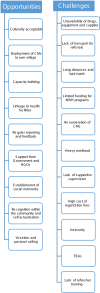Opportunities and challenges in implementing community based skilled birth attendance strategy in Kenya
- PMID: 25128479
- PMCID: PMC4262243
- DOI: 10.1186/1471-2393-14-279
Opportunities and challenges in implementing community based skilled birth attendance strategy in Kenya
Abstract
Background: Availability of skilled care at birth remains a major problem in most developing countries. In an effort to increase access to skilled birth attendance, the Kenyan government implemented the community midwifery programme in 2005. The aim of this programme was to increase women's access to skilled care during pregnancy, childbirth and post-partum within their communities.
Methods: Qualitative research involving in-depth interviews with 20 community midwives and six key informants. The key informants were funder, managers, coordinators and supervisors of the programme. Interviews were conducted between June to July, 2011 in two districts in Western and Central provinces of Kenya.
Results: Findings showed major challenges and opportunities in implementing the community midwifery programme. Challenges of the programme were: socio-economic issues, unavailability of logistics, problems of transportation for referrals and insecurity. Participants also identified the advantages of having midwives in the community which were provision of individualised care; living in the same community with clients which made community midwives easily accessible; and flexible payment options.
Conclusions: Although the community midwifery model is a culturally acceptable method to increase skilled birth attendance in Kenya, the use of skilled birth attendance however remains disproportionately lower among poor mothers. Despite several governmental efforts to increase access and coverage of delivery services to the poor, it is clear that the poor may still not access skilled care even with skilled birth attendants residing in the community due to several socio-economic barriers.
Figures
References
-
- WHO . Trends in maternal mortality: 1990 to 2008-Estimates developed by WHO, UNICEF, UNFPA and The World Bank. Geneva: WHO press; 2010.
-
- Darmstadt GL, Lee ACC, Cousens S, Sibley L, Bhutta ZA, Donnay F, Osrin D, Bang A, Kumar V, Wall SN, Baqui A, Lawn JE. 60 million non-facility births: who can deliver in community settings to reduce intrapartum-related deaths? Int J Gynaecol Obstet. 2009;107(Suppl 1):S89–S112. doi: 10.1016/j.ijgo.2009.07.010. - DOI - PMC - PubMed
-
- Wagstaff A, Cleason M. The Millennium Development Goals for Health: Rising to the Challenges. Washington: The World Bank; 2004.
-
- WHO . Making pregnancy safer: The critical role of the skilled attendant-a joint statement by WHO, ICM and FIGO. Geneva: World Health Organization; 2004.
Pre-publication history
-
- The pre-publication history for this paper can be accessed here: http://www.biomedcentral.com/1471-2393/14/279/prepub
MeSH terms
LinkOut - more resources
Full Text Sources
Other Literature Sources
Molecular Biology Databases


